Sad to report we’re struggling mightily with our current Wired opus. Can’t quite get the lede to sing, and we’re getting lost in the weeds on Section One—so much controversial history to pack into just a few hundred words. Plus we’ve got one last interview to nail down, without which this piece might never gel. So please excuse us while we attend to pressing matters; we’ll be back here as soon as we’ve broken through the haze.
Oh, My Aching Hands…
March 4th, 2010
Mines Never Sleep
March 4th, 2010
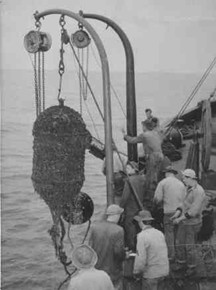 From the frigid waters of the Baltic Sea, a depressing reminder about the extremely long-term dangers posed by mines:
From the frigid waters of the Baltic Sea, a depressing reminder about the extremely long-term dangers posed by mines:
Dozens of Second World War mines that litter the floor of the Baltic Sea will be detonated by a British company this spring in the biggest commercial mine-clearance programme in history.
Sebastian Sass, head of EU representation for Nordstream, the company behind the €7.5 billion (£6.5 billion) project, said: “We have tried to establish a corridor for the pipeline that avoids the areas where we know there are the most munitions. But we still need to clear about 70 by blasting.”
He said it would take up to two days to clear each mine, some of which contain 300kg of high explosive. The full operation, which can take place only in good weather.
For our fellow gearheads in the audience, here’s the skinny on how the clearance will be done. Robots will be do the hard part—actually placing the charges next to the unexploded mines—so the employees of Bactec International at least have better jobs than this poor bloke.
The Baltic Sea situation makes us wonder how many unexploded mines may still pepper the floor of San Francisco Bay. Yes, we mined the heck out of that scenic, shark-infested waterway.
→ 2 CommentsTags:Bactec International·Baltic Sea·California·landmines·maritime·robots·San Francisco·UXO·World War II
Bulletproof: Jimmy Rasta and the Malaitans
March 3rd, 2010

The long spell of political violence that rocked the Solomon Islands last decade, commonly referred to as “The Tensions,” is an episode we know far too little about. We were thus delighted to stumble across this excellent post-mortem from New Zealand’s Sunday Star-Times, which details how the conflict’s aftermath still lingers in a major way. Like much of the best non-fiction, it combines general history with the narrative of a single man: feared warlord Jimmy “Rasta” Lusibaea, who led an ethnic militia called the Malaita Eagles Force. His amazing story includes a snippet that dovetails perfectly with our ongoing Bulletproof Project, in which we’ve been chronicling the demonstrably false claims of mystics that certain rituals, talismans, or beliefs can protect warriors from gunfire. Before picking up arms for the first time, Lusibaea was duped in such a manner:
Before their pacification by Christian missionaries, Solomon Islanders were fearsome headhunters. The people of Malaita, the largest and most influential ethnic group, still hold tightly to many of their old customs. Prior to battle, Lusibaea was beaten and put through the fire as part of traditional rituals of invincibility. “If they fire the rifle, I can dodge the bullet,” he says. “That’s why I’m still alive.”
Despite having committed numerous atrocities during The Tensions, Lusibaea is now a free man—he served just five years in prison for assault, while skating on more serious charges. During his time behind bars, he claimed to rediscover his Christian faith, and has since sought forgiveness from those he wronged—forgiveness that has been heavily ritualized in public ceremonies.
Lusibaea’s redemption arc is actually something we’ve seen before, in the strange case of Joshua Milton Blahyi, better known to the world as General Butt Naked.
(Image of Lusibaea’s baptism via xleetalo
→ 4 CommentsTags:Liberia·religion·Solomon Islands·The Bulletproof Project
Giving the Junta a Pass
March 2nd, 2010

The recent Nigerien coup has put the rest of the world—or at least the part that swears love for democracy—in something of a quandary. Out deepest political principles compel us to oppose the use of force in obtaining power, especially when the afflicted regime was selected at the ballot box. Yet if the old guard was deeply rotten, do we really have the moral authority to condemn non-democratic change? Especially if, as in Niger, the incoming junta seems significantly less toxic than what it replaced:
The soldiers who overthrew Mamadou Tandja are vowing to restore civilian rule, an assertion that has often proved hollow among Africa’s myriad juntas. The difference in Niger, though, is profound: Most people here actually believe them.
“For democracy activists like us, it’s difficult to applaud a coup d’etat,’’ said Marou Amadou, a leading human rights worker who was jailed for a month and beaten by security forces during Tandja’s regime. “But this had to happen and we are overjoyed. There was no other way.’’
Though officially condemned by governments worldwide, Tandja’s ouster has been widely praised at home: by unions, human rights groups, civil society leaders, abd local media. The trust is so great, in fact, that the director of one widely respected independent Niamey newspaper was working protocol for the junta.
We have to say, though, we’re troubled by the utter pleasantness of the junta’s name: the Supreme Council for the Restoration of Democracy. In our experience, the more genial a junta’s name, the likelier it is to turn evil. Cases in point: the State Peace and Development Council, the Committe of Public Safety.
We are also discouraged by the fact that the Supreme Council has yet to update the official website of the Nigerien presidency. No good junta worth its salt should be without a webmaster these days.
Working the Lede
March 1st, 2010
By the time this post goes live, we’ll hopefully be halfway through the lede on our next Wired opus. Though given our lackluster writing speed these past few days, we’re starting to wonder if we’ll ever get through this beast. Seriously, few things are more discouraging than closing your laptop at day’s end and realizing that hours worth of your finest mental efforts resulted in the product of a mere 200 words—and mediocre words, at that.
On the other hand, yes, we realize there are far, far worse jobs in this world. We should obviously be counting our blessings.
Comments Off on Working the LedeTags:hip-hop·housekeeping·MF Doom·music
Let It Grow
March 1st, 2010
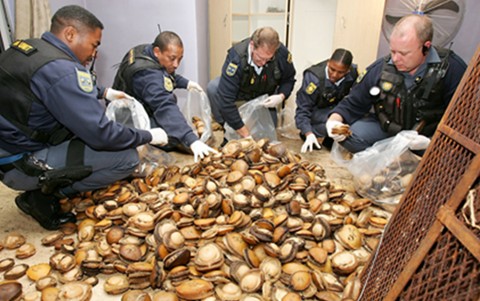 Whenever we find ourselves wandering around a massive Chinese supermarket, we inevitably gawk at the price of dried abalone. The delicacy has never crossed our lips thanks to its exorbitant cost. But millions of Asian consumers are willing to fork over the pretty penny, in part due to the marine snail’s reputation as an aphrodisiac.
Whenever we find ourselves wandering around a massive Chinese supermarket, we inevitably gawk at the price of dried abalone. The delicacy has never crossed our lips thanks to its exorbitant cost. But millions of Asian consumers are willing to fork over the pretty penny, in part due to the marine snail’s reputation as an aphrodisiac.
That demand has caused serious problems in South Africa, where Chinese triads poach thousands of tons of abalone each year, often by swapping methamphetamine for shellfish. As a result, South Africa’s abalone fisheries could completely collapse within the next three to four years, robbing the Western Cape of one of its most valuable commodities.
With demand unlikely to debate as China’s middle class develops, and law enforcement seemingly powerless to stem the tide in South Africa, perhaps it’s time for Option C: enabling China, Japan, and other Asian nations to grow their own. This can be done in such a manner that South Africa isn’t cut out of the economic gains—instead of providing the abalone, it can provide the specially engineered food, which is best grown in the mollusks’ indigenous environments.
Granted, China’s previous experiments with abalone farming have not gone well. But the expertise to avoid such pitfalls can be imported from South Africa, too. Perhaps the abalone barons of the Western Cape simply need to realize that their future lies in services, rather than the biological version of manufacturing.
Comments Off on Let It GrowTags:abalone·China·crime·drugs·economics·methamphetamine·South Africa·wildlife management
That’s What You Get for Not Hailing to the Chimp
February 26th, 2010
We have never attempted to conceal our fascination with movies starring non-human primates. That quirk of our character shines through yet again in this week’s Bad Movie Friday installment, featuring the 1951 Ronald Regan vehicle Bedtime for Bonzo. Suffice to say that the trailer above makes us weep for the scientific literacy of Eisenhower Era schoolchildren, as Bonzo is unfortunately referred to as a monkey rather than a chimpanzee. Critics of the day, however, seemed more concerned with the film’s other shortcomings:
Bonzo, it is needless to say, is a capricious chimp who is cute in bed, on a tricycle, up in a tree or flabbergasting the operators as he jabbers into a phone. Ronald Reagan, as the professor; Diana Lynn, as Bonzo’s “momma;” Walter Slezak, as Reagan’s sympathetic colleague, and Lucille Barkley, as the Dean’s cool and intellectual daughter, work hard but obviously ineffectively. They haven’t a chance since Bonzo makes monkeys of all of them.
There was a sequel, too, which looks even more dire than the original. Tragically, Bonzo Goes to College starred a different chimp than the original. Tamba, the Liberian-born ape who upstaged the future president, perished in a fire at the height of his celebrity. At the time, he was earning $500 per week—over four grand in today’s dollars. We hope he got enjoy his wealth during his all-too-brief time on Earth. But somehow, we rather doubt it.
Comments Off on That’s What You Get for Not Hailing to the ChimpTags:animals·Bad Movie Friday·chimpanzees·movies·primates·Ronald Reagan·Tamba
A Taxidermist’s Best Friend
February 26th, 2010
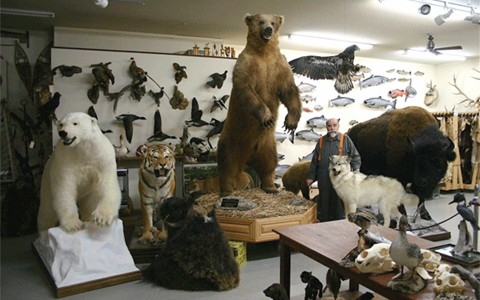
Nearly a year ago, we marveled at the way in which ancient physicians used ant jaws as sutures. Blame our childhood Flintstones habit, but we have a soft spot for techniques that require the assistance of live animals. And so imagine our glee upon discovering the role that dermestid beetles play in the twin disciplines of taxidermy and fossil cleaning.
We should probably take a step back for a moment and recount how we stumbled upon this wondrous scrap of knowledge. It came up during our perusal of an indispensable (and slightly gross) guide to distinguishing between real and fake tiger penises. Due to the heavy illegal trade in tiger genitalia, some unfortunate employees of the U.S. Fish and Wildlife Service must regularly analyze seized products that purport to be feline penises. As it turns out, the vast majority of these products are fakes—the members of horses or deer gussied up to appear as if they were taken from tigers. The guide’s advice to rookies assigned to this discernment task essentially boils down to this:
The penis from a real tiger has a small triangular baculum, but it is seldom visible even in an x-ray, being obscured by folds in dense, dried tissues. The genitalia of other mammals are used in the wildlife trade, and can usually be identified by the size and shape of the internal penis bone or baculum. Sometimes the dried genitals must be macerated or cleaned by dermestid beetles to extract the baculum. X-rays are the best screening tool for initial examination of the dried penis. An expert should be consulted to interpret the radiographs.
How could we resist the image of humble beetles being called in to do a job that mankind’s most advanced chemicals cannot? In fact, the work of the beetles must be vastly superior to whatever super-bleaches can accomplish; otherwise, it’s hard to imagine any taxidermist going through the trouble of maintaining a beetle colony.
Dermestid beetles are also frequently used in forensic entomology, in order to date human remains. And they’ve apparently been at their bone-cleaning work for many millennia, given that their bites have been discovered on dinosaurs. If you have the stomach for it, click here to see the critters at work. Readers of a more sensitive constitution, please go here instead.
(Image via Gander’s Taxidermy)
→ 8 CommentsTags:crime·dermestid beetles·insects·paleontology·taxidermy·tigers·wildlife management
Echoes of the Empire
February 25th, 2010
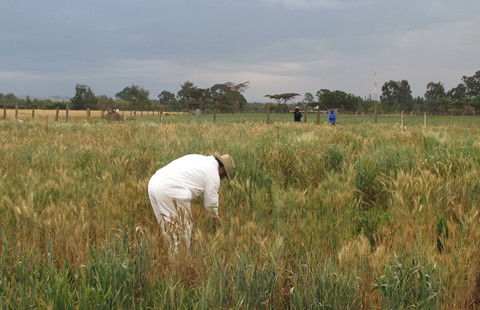
This will be our last Ug99-related post, we promise. But before we ended our brief run of bonus material related to “The Red Menace”, we thought we’d shout out one of the potential heroes of this story: the late A.E. Watkins, a British botanist who spent much of the 1930s roaming the globe in search of wheat varieties. The desiccated seeds of these wheats are now stored at the John Innes Centre in Norwich, England.
Of what possible interest to science could samples of archaic Cypriot, Syrian, and Armenian wheats be to today’s scientists? As it turns out, one of Watkins’ prizes could hold the genetic key to defeating Ug99.
If that does end up being the case, though, it will raise an interesting ethical dilemma. A man like Watkins could not possibly embark on his collecting project today. Germplasms are widely considered part of a sovereign nation’s heritage, and thus can’t be carted away be foreign interlopers. During the height of the British Empire, of course, Watkins was faced with no such legal hurdles.
This is not to imply that countries should allow every Tom, Dick, and A.E. to tramp through their fields at will. But there is something to be said about sharing genetic resources for the good of all mankind. The key is making sure there are safeguards in place so that no one profits financially from such generosity. We certainly wouldn’t want a foreign company to patent something off of one of our treasured crops.
(Image by Microkhan. The man in the white jumpsuit is Harbans Bariana, one of the main men exploring Watkins’ germplasm.)
→ 7 CommentsTags:A.E. Watkins·Britain·England·genetics·Ug99·wheat·Wired
Nothing Like the First Time
February 25th, 2010
 In researching our forthcoming Wired piece on drug and alcohol abuse, we’ve found ourselves keenly interested in the tales that addicts tell about their first inebriatory experiences. One common thread we’ve found is a sense that the first drink or dose provided something that the person had always been searching for—the intoxicant made them whole, in an odd way. And though it is certainly a cliché, these afflicted souls can spend lifetimes trying to recapture that sensation of wholeness.
In researching our forthcoming Wired piece on drug and alcohol abuse, we’ve found ourselves keenly interested in the tales that addicts tell about their first inebriatory experiences. One common thread we’ve found is a sense that the first drink or dose provided something that the person had always been searching for—the intoxicant made them whole, in an odd way. And though it is certainly a cliché, these afflicted souls can spend lifetimes trying to recapture that sensation of wholeness.
The most telling anecdote we’ve yet come across is from none other than Bill Wilson, aka Bill W., the man who founded Alcoholics Anonymous. A shy and sensitive kid from Vermont who had recently been inducted into the Army, Wilson took his first drink at a 1917 dance near Fort Rodman, Masschusetts. He recounted the wonder of that experience a half-century later to his authorized biographer, who told the story thusly:
Perhaps it took a little time, but it seemed to happen instantly. He could feel his body relaxing, a stiffness going out of his shoulders as he sensed the warm glow seeping through him into all the distant, forgotten corners of his being. Then, unaccountably, the room was tilting, and he was sure he would slide down to the floor, but gradually everything evened off. And he found he was beginning to talk—not just answering now but bringing up subjects on his own—and apparently he was being amusing…It was wonderful to be so free and so witty…
He stared at the drink in his hand and as he did he felt a numbness in his arms and legs, a sudden pounding in his chest, all the old signs of terror grabbing him. But by some great, inexplicable miracle, it lasted only a moment. Then another, older, wiser, infinitely stronger Bill seemed to be there and to be taking possession of him…
At his back he could hear the whine of a saxophone, little waves of voices rising, falling, but now they in no way ran against the overwhelming joy he was feeling. His world was all around him, young and fresh and loving, and as he made his way down the drive he moved easily, gracefuly, as thouhg—he knew exactly how he felt—all his life he had been living in chains. Now he was free.
Our first thought upon reading this passage? “We’ll have what he’s having.” But then it got us to wondering: What might this story teach us about the nature-versus-nurture argument as it pertains to addiction? Was Wilson’s dopamine pathway simply primed to enjoy alcohol to such an inordinate degree that he never stood a chance once the neurotransmitters flooded his brain? Or did alcohol just come along at the right time in his life, as he teetered between adolescence and maturity, and was thus an easy mark for any substance, concept, or diversion that might alleviate his anxiety?
Tough questions to answer, of course. For the moment, all we know is this: Our first drunken experience, which involved a bottle of tequila and a vacant lot, was nowhere near as transcendent as Wilson’s.
→ 1 CommentTags:addiction·alcohol·alcoholism·neuroscience·psychology
The Undertow
February 24th, 2010
Already plugging away on our next Wired feature, this time about addiction rather than wheat-devouring fungi (or, for that matter, the creative benefits of social media. Today’s outline day, which is always a chore—envisioning the structure of a lengthy magazine piece requires even more mental bandwidth than we usually utilize. Fortunately, we’ve got The Skatalites to maintain our neural energy. We actually fell in love with this track by listening to Madlib’s Blunted in the Bomb Shelter mixtape, which we can’t possibly recommend highly enough. The scratchy 45-rpm version is still where it’s at, as the various live versions floating around tend to sound too clean for our ears. There’s definitely a lot to be said for dither.
Using the Red Menace Against the Reds
February 24th, 2010
 One of the most interesting things about Ug99, the fungus that is currently threatening the world’s wheat supply, is how it managed to sneak up on us. For nearly four decades, the disease that the Puccinis graminis pathogen causes, known as stem rust, was little seen in the wild, and certainly no great peril to farmers. That’s because of the heroic efforts of Dr. Norman Borlaug and his acolytes, who managed to imbue the world’s wheat with genes capable of resisting P. graminis. So as early as the 1960s, agricultural researchers started to forget that stem rust had once been the nastiest plant disease known to man.
One of the most interesting things about Ug99, the fungus that is currently threatening the world’s wheat supply, is how it managed to sneak up on us. For nearly four decades, the disease that the Puccinis graminis pathogen causes, known as stem rust, was little seen in the wild, and certainly no great peril to farmers. That’s because of the heroic efforts of Dr. Norman Borlaug and his acolytes, who managed to imbue the world’s wheat with genes capable of resisting P. graminis. So as early as the 1960s, agricultural researchers started to forget that stem rust had once been the nastiest plant disease known to man.
But you know who didn’t forget? The good folks over at the Pentagon, who spent many years trying to turn stem rust into a bioweapon. To do so was no mean feat, seeing as how they needed to grow and harvest spores of a highly sensitive nature, then figure out a way to drop them on the Soviet Union with no one being the wiser. To accomplish the later task, Army researchers did a little modding of pre-existing hardware:
The most novel innovation was the feather bomb, which featured a 500-pound aerial bomb ordinarily used to spread propaganda leaflets. The bomb was packed with turkey feathers infused with the dust of fungal spores. The feathers were released at high altitudes, drifting over a wide area and coating leaves with spores.
The feathers were the best delivery mechanism because they still retained about 10 percent of their spores despite being subjected to harsh climactic conditions (of the sort you might experience at high altitude). And they also drifted down to Earth with nary a sound, and spread over a wide area so as not to attract the attention of any nosy Soviet farmers.
Needless to say, we never did get around to trying to destroy the Communist wheat crop. But if nothing else, the current Ug99 epidemic proves that our Cold Warriors had a real genius for mischief.
→ 3 CommentsTags:agriculture·Cold War·Soviet Union·Ug99·wheat·Wired
Shell Game
February 24th, 2010
 The Wired cover story this month is not our Ug99 opus, but rather a brilliant meditation on the future of money. A couple of years hence, you can forget about the ATM—just think “pay this man,” and neural implants will automatically wire dough from your bank account to your creditor. Or something like that.
The Wired cover story this month is not our Ug99 opus, but rather a brilliant meditation on the future of money. A couple of years hence, you can forget about the ATM—just think “pay this man,” and neural implants will automatically wire dough from your bank account to your creditor. Or something like that.
In the Solomon Islands, however, the future of money is looking very much like the past, at least when it comes to settling local debts:
Mother of Shell Money Hilda Gelulu from Surabotaá in Langalanga constituency in Malaita province is proposing to establish a Shell Money factory in the country.
Mrs Gelulu who is been in the trade for over 30 years said the idea of establishing the factory is to maintain the culture of making money in the country.
She said Shell Money is very useful in times of settling disputes, paying of bride prize, compensation and buying property.
“Importantly Shell Money is our trade mark seen in our ten dollar notes,” she said.
At the moment she has four thousands bags of shell money to kick of the factory.
Plenty more on the economics of the practice here. Yes, alternate currencies naturally threaten the stability or legitimacy of a nation’s legal tender. But if the usage can be limited to certain locales that have a difficult time attracting paper currency, the upside is probably worth the risk.
→ 2 CommentsTags:currency·economics·shell money·Solomon Islands·Wired
The Red Menace
February 23rd, 2010
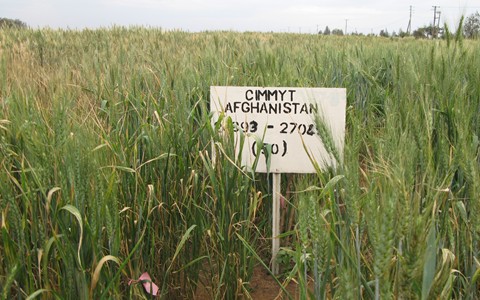
It took over half-a-year, but the Wired piece that brought us out to Kenya last fall is finally live. It’s the tale of a wheat-killing fungus called Ug99, which is currently sweeping across Central Asia. The pathogen is remarkable because it can easily overcomes the genetic defenses created by the Green Revolution. As a result, the vast majority of the world’s wheat is susceptible to Ug99, and a major catastrophe could ensue if nothing is done to halt the epidemic’s spread.
We’ll be posting bonus material all week, so fear not—your Ug99 jones shall be sated. For the moment, though, we’re just going to point you toward one of the most interesting aspects of the article: the tale of the man who discovered Ug99, a Ugandan wheat breeder named William Wagoire. When news broke of the pathogen’s presence in southern Uganda, Wagoire should have been celebrated as a scientific hero. Instead, he was villified:
Uganda’s tabloid press jumped on the story. Kampala newspapers manipulated the facts to demonize Wagoire, making it appear as though he had somehow synthesized Ug99 in a lab. Accustomed to hearing tales of how Western scientists had invented HIV, the Ugandan public was all too willing to swallow the sci-fi narrative. “The local politicians and the general populace, they do not know about the evolution of diseases,” Wagoire says. “All they know is that research scientists work in laboratories and that diseases are in laboratories. So in this case, the story was ‘Wagoire has created a disease which is going to wipe out all the wheat in the world!’ That was a very trying time for me.”
We do, of course, urge you to read the whole thing, then help spread the word. Erokamano, dear readers.
(Image by Microkhan. It’s a photo we snapped of Afghanistan’s “test wheat,” planted at Njoro, Kenya, where Ug99 is in the wild.)
→ 6 CommentsTags:Afghanistan·agriculture·famine·Kenya·Ug99·Uganda·wheat·Wired
The Appeal of Uniformity
February 23rd, 2010
An Applebee’s recently opened up here in Atlah, and it’s doing pretty decent business on a strip of 125th Street that attracts scant foot traffic at night. Perhaps we shouldn’t be surprised at the restaurant’s success, seeing as how we praised the chain’s business acumen in a 2005 Slate column. But we do find it a bit disconcerting that so many diners opt for the familiar, despite the abundance of higher-quality local joints within a half-mile radius. (Every single item on the menu at Tropical Grill is vastly superior to Applebee’s warmed-over offerings.)
But the majority of consumers prefer to bet on a sure thing rather than gamble on an unknown quantity. And few businessmen of recent vintage have had a better understanding of that truism than Sam Ross, the man who founded Fantastic Sam’s (aka Fantastic Sams—the current owner didn’t think that America could handle the apostrophe s). Ross’s masterstroke was compelling employees to go by pre-selected nicknames, which resulted in a uniformity of experience that should be the envy of McDonald’s:
Through a series of sometimes ingenious moves, hair care franchisers attempt to convince the consumer that all stylists in their salons are the same. Fantastic Sam’s, the nation’s leading hair care franchise, did not allow its stylists to use their own names; instead, they had to accept standardized nicknames (such as Bubbles or Peaches). Every Fantastic Sam’s outlet had a Bubbles and the consumer could get his hair cut by Bubbles in Los Angeles or in New York. Even the stylist’s business card had to carry the standardized nickname and not her real name.
Note that we had to change the above quote to the past tense, since the chain no longer forces a narrow range of nicknames upon its stylist. As it turns out, some women took great offense to being forced to go through life as “Buttercup” or “Foxy.”
By the way, we included the clip above only because it’s such a great example of a classic Madison Avenue technique: stacking the deck. The narrator is right—you really can’t tell the two haircuts apart. But there’s something else about those ladies that makes them look quite different from one another. Whatever could it be?
→ 3 CommentsTags:advertising·business·Fantastic Sams·marketing·psychology
Ending the Cycle of Blood
February 23rd, 2010
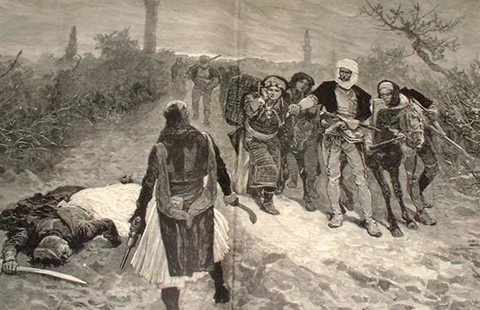
In reading about the persistence of clan feuding on Mindanao, we got to thinking about how governments can best end such cycles of revenge. Our natural assumption is that these feuds exist where organized justice is in short supply, and so familial units take over the role of punishing offenders. But a University of Maryland offers a different take here:
Extracting revenge by killing people and engaging in a blood feud is not, as one might be tempted to think, just a way to extract justice in absence of a judiciary system. It is, in fact, a way to send the signal that one’s clan (group) is ready to protect their right to exist without actually having to engage in a conflict over the means and sources of survival. The desire to send this signal and the inability of clans to read into other clans’ readiness to fight causes them to exchange more “signals” (killings) than they would have had they been fully informed about that readiness.
In such cases the access of all agents in a society to alternative economic activities, in which output is a function of individual e ffort rather than clan belongingness, is crucial in changing the valuations and payo ffs and breaking the socially inefficient path dependence. This might come through access to outside labor markets (migration) or through the accepted establishment of an authority that provides both economic welfare and protection. The new payo ff structure, if long-lasting, will provide incentives to the society to renegotiate and redesign new institutional arrangements, drifting away from the feud-perpetuating collective responsibility system.
The big caveat in all this, though, is that the creation of those “alternative economic activities” cannot be viewed as a blatant attempt to end the feuding. Clans do take pride in their reputations for ferocity, and thus recoil at the thought of being emasculated by a central government. The trick, as is so often the case, is to provide carrots that can be accepted without loss of face. Easier said than done, of course.
Days Like This
February 22nd, 2010
At some point in the not-too-distant future, we hope that the considerable time we spend on Microkhan will lead to some sort of remuneration (apart from the obvious psychic rewards). But until we figure out a way to turn y’all’s interest in Hmong beauty pageants, Medieval drinking habits, and boxing kangaroos into some sort of hard currency that’ll keep Microkhan Jr. awash in his beloved strawberries, there are gonna be days like this—days in which we must forgo tending to this blog in the name of hitting paying deadlines (in this case, for our next Wired column). Check out the classic Marvin Gaye track above as we churn out the pithy words o’ wisdom, and we promise to circle back to you as soon as we’re able.
The Ride Og Wishes He Had
February 19th, 2010
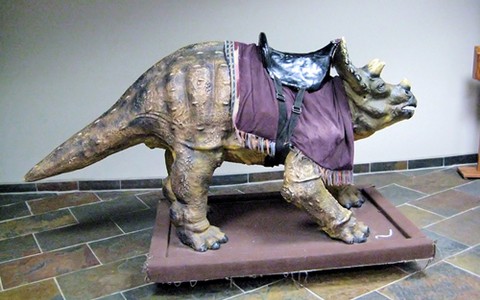
We realize we should stop being surprised by the scientific illiteracy of our countrymen, but we just couldn’t let this loopy tidbit pass without notice:
Did humans live at the same time as the dinosaurs? Three in ten Texas voters agree with that statement; 41 percent disagree, and 30 percent don’t know.
We have a deeply personal reason for recoiling at such dunderheadedness. About a decade ago, during our cub-reporter days, we were assigned to participate in a “creation safari”. This was a day-long event in which we caravaned around Eastern Kansas along with roughly a dozen families, in search of the invertebrate fossils that are abundant in the state’s rock. We’d occasionally stop to hear a brief lecture about how those fossils were created in the first place, along with ancillary information that conformed with the creationist mindset.
At one such stop, a child of roughly 10 or 11 asked a very good question: Why are dinosaur fossils buried so deep in the ground? Yet the instructor wasn’t flummoxed in the least. He quickly responded that during the Great Flood, all animals ran up hills and mountains in order to escape the deluge. Because the dinosaurs were large and slow, he said, they were the laggards in the footrace, and were thus the first to be killed. The mammals, by contrast, were speedy, and made it to the hilltops before suffering their own grim fates.
We sort of wish that journalistic ethics hadn’t precluded us from raising our hand and asking how this theory accounted for Compsoganthus and Archaeopteryx. But we did the right thing and bit our tongues. Here’s to hoping, though, that the kid who asked the question maintained his healthy curiosity despite constantly being spoonfed “facts” of a most dubious nature.
By the way, the image above comes from this uproarious Flickr set of photos snapped at the Creation Museum. To the creationists’ credit, they do appear to have a lively sense of humor.
→ 2 CommentsTags:Creation Museum·creationism·dinosaurs·evolution·Kansas·pseudoscience
Carving Out a New World
February 18th, 2010
If you haven’t caught it already, The Independent‘s latest dispatch from the jungles of Laos is well worth a read. It’s an eye-opening look at life for the Hmong tribespeople who decided to remain in Southeast Asia after the end of the Vietnam War, rather than take the CIA up on its offer to resettle them in America. (The full background on that drama here.) These Hmong continue to be hunted by their former Communist foes, and thus live in abject circumstances while on the run. It is a brutal way to live:
Frequent attacks force the groups to change camp every two weeks and break up into small numbers to avoid large-scale offensives by the Laos army. This leaves the community no chance to farm food or forge a proper way of life. With no other choice, boiled tree shrub has become their daily diet and at times they are lucky if they can catch a jungle rat or monkey. The lack of nutrients has left the group visibly malnourished – both young and old have swollen abdomens.
Eating the tree shrub leaves them starving, so like animals, women and children take to the surrounding hills to dig on their hands and knees. Outside the camp, they claim that many women and children have been killed by the Laos army and the “lucky ones” have bullet wounds to show.
What makes this piece all the more startling is the obvious contrast that pops to mind: How much these lives differ from those of Hmong who chose to take Uncle Sam up on his resettlement offer. In the mid-1970s, the thought of going into overseas exile must have seemed absolutely terrifying to Hmong refugees, who certainly had no inkling that the Communists’ vendetta would last for another 35 years. But those who gambled on immigration have largely reaped tremendous rewards, including a growing measure of political power. And there is perhaps no surer symbol of that prosperity than the annual Miss Hmong International pageant, an event that could only occur once significant prosperity had been obtained.
The clip above features Nkauj Mog Mim Hawj, the reigning Miss Hmong International; we’ve got it cued up to the most salacious part, which is still about 100 times tamer than anything you’ll see at Miss America. (It’s all about her calves, not her curves.) We do like the fact, however, that the young lady also has her ardent critics. No beauty pageant can be truly American until it includes some mean-spirited sniping, after all.
→ 1 CommentTags:Hmong·immigration·Laos·Miss Hmong International·Vietnam War
The Questionable Power of Horse
February 18th, 2010
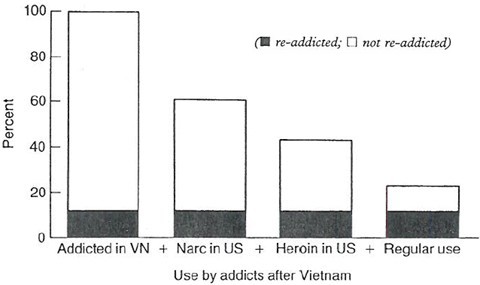
In keeping with our recent paying-gig focus on addiction science, we’d like to turn your attention toward the remarkable work of Lee N. Robins, who recently passed away. In the early 1970s, after hearing rumors that tens of thousands of Vietnam War veterans had come stumbling home as hopeless heroin addicts, Robins vowed to determine whether that was really the case. She found that although drug abuse had been alarmingly common on the battlefield, with a third of Army enlistees trying heroin and 20 percent suffering through the symptoms of addiction, everything changed once the soldiers came home. Remarkably, only a small percentage continued their drug use on the homefront, and those vets were a predictable lot—namely, men who had abused drugs prior to the war (see above).
After publishing her findings in 1973, Robins spent the rest of her career defending her contrarian conclusion regarding the real power of opiates. She always did so with unusually keen intelligence, as evidenced by this snippet from this 1993 lecture:
Beliefs about heroin based entirely on results in treated populations have created a self-fulfilling prophecy. Heroin is thought of, by law enforcement personnel and users alike, as the “worst” drug, virtually instantly and permanently addictive and creating craving so extreme that it overcomes all normal ability to resist temptations to theft and robber to acquire it. Users who share that view show by their use that they are ready to commit themselves to their concept of an addictive lifestyle. The public’s ranking of drugs with respect to “hardness’ probably has more to do with the drug’s legal status, the government’s commitment to discouraging its use, and its price than any intrinsic addictive liability. This is best demonstrated by tobacco, a highly addictive drug ranked as “soft.”
Robins was obviously trying to be provocative with that last statement, and she surely wouldn’t want heroin to be as easily accessible as cigarettes. But her point is valid, as far as treatment goes—could we more effectively wean users off heroin by treating them as no less “sick” than smokers who need the patch? Should the treatment of heroin addiction be normalized, so that those who’ve deigned to use the drug aren’t immediately shunted into a severe program that doesn’t address their underlying psychological issues?
→ 8 CommentsTags:addiction·drugs·heroins·psychology·Vietnam War
A Master’s Secret
February 17th, 2010
Contrary to what you might conclude by checking out our “music” tag, we don’t only permit hip-hop, soul, and vintage ZZ Top to enter our eardrums. We’ve also taken quite a shine to ukulele music in recent weeks, a jag that has brought us in touch with the work of the late, great John King. True, you might quibble with the fact that King lived in Florida rather than Hawaii, the supposed motherland for ukulele music (though Portugal has a better claim to that title). But no one can dispute King’s mastery of the instrument, which he stretched into the virtuosic reaches of the classical realm.
We also appreciate the innovative means by which King maintained his focus during concerts:
John had a unique method for keeping his mind focused when he became distracted during a performance: he would visualize breasts. Beautiful, natural breasts. That, he said, would calm his mind and allow him to get “back in the zone.”
More of King in action here. Unlike Lord Finesse, it’s perfectly safe for work.
→ 4 CommentsTags:classical music·John King·Lord Finesse·music·psychology·ukulele
If Vulcan Rears His Head
February 17th, 2010

Because so few potential clients are directly threatened by volcanoes, the insurance industry hasn’t developed sophisticated models to estimate damage due to cataclysmic eruptions. But sooner or later, a volcano located near a major population center is going to blow, and government cash alone may not be enough to heal the economic wounds. Could the insurance industry fill the void while making a tidy little profit to boot? A pair of British researchers make the case, asserting that it’s entirely possible to guess how many lives and homes will be destroyed by an eruption. The impact of Mount Vesuvius on Naples provides their central object lesson:
In terms of human casualties, the impact depends on the extent of evacuation achieved, and a very effective evacuation is assumed in which 98.5% of the population have been evacuated by the end of Phase 1. However, given the immense population at risk there would still be an estimated 8,000 deaths and 13,000 injuries resulting from this large-scale eruption, and there are also certain to be insurance implications from these casualties.
The authors do note, however, one potential complicating factor in the nascent volcano-insurance field: whether to issue policies that can cover the climate-altering effects of major eruptions, too. Think that sounds far-fetched? Meet Mount Tambora, the Indonesian volcano responsible for the infamous “Year Without Summer.”
→ 6 CommentsTags:economics·Indonesia·insurance·Italy·Mount Tambora·Mount Vesuvius·volcanoes
Lord of the Snow
February 16th, 2010
 Big doings up in the Yukon yesterday, as Austrian dog-sledding superstar Hans Gatt captured his fourth Yukon Quest title. If you’ve ever been curious about the strategies employed by professional mushers during their competitive odysseys, we highly recommend the invaluable “Check Point” blog, which is sort of the ESPN.com of dog sledding. We especially enjoyed the blog’s account of the Quest’s final phase, when subterfuge and grit came into play:
Big doings up in the Yukon yesterday, as Austrian dog-sledding superstar Hans Gatt captured his fourth Yukon Quest title. If you’ve ever been curious about the strategies employed by professional mushers during their competitive odysseys, we highly recommend the invaluable “Check Point” blog, which is sort of the ESPN.com of dog sledding. We especially enjoyed the blog’s account of the Quest’s final phase, when subterfuge and grit came into play:
Gatt made a nice move before reaching Pelly, pulling over at the Stepping Stone hospitality stop for two hours, which gave his dogs food, water and rest, and put Mackey and Neff in the less favorable position of breaking trail for a few hours. He followed them in to Pelly Crossing by two hours, let them believe he was taking a longer rest, but hopped up and followed them out of that checkpoint. He was down to nine dogs, about the same number as Mackey and Neff.
Gatt kept on Neff and Mackey’s heels all the way to Carmacks, where they all took off together for the final key run to the mandatory eight-hour layover at Braeburn. That run, through the heat of the day, proved that Gatt and his dogs had a little something left over that the other two could not match. He swept into Braeburn 34 minutes ahead of Mackey and an hour ahead of Neff. That size of a gap is nearly insurmountable at this stage of distance racing, when all teams have slowed to a 6 to 7 mph trot.
Gatt, by the way, sounds like one fascinating character. Check out his line of handcrafted dog sleds here. And don’t forget about the brake pads.
Comments Off on Lord of the SnowTags:Alaska·Canada·dog sledding·Hans Gatt·sports·Yukon·Yukon Quest
Choke on This
February 16th, 2010

There’s an old chestnut (of dubious veracity) about how more rock climbers perish in auto accidents to-and-from the cliffs than from accidental falls. We thought of that contrarian info-nugget this morning upon stumbling across some surprising morbidity news from Britain:
Last week, the House of Commons’s Environmental Audit Committee heard evidence that about 35,000 people – or 51,500, if you use the methodology devised by the European Topic Centre on Air and Climate Change – died prematurely in 2005 as a result of exposure to tiny airborne particles generated by traffic. Professor Frank Kelly, an environmental health expert at King’s College London, claimed that about 3,500 and possibly up to 8,000 deaths in London alone could be attributed to this kind of pollution.
At the same time, “only” 2,600 Britons lose their lives in vehicular wrecks each year, which makes tailpipe emissions a far more prolific killer than mere accidents.
Yet despite those ghoulish figures, why do we get the feeling that no great alarm will be sounded? The problem is that our brains naturally assign a higher fear value to violent deaths than those due to chronic illness, and so we allocate disproportionate resources to the smaller issue. On top of that, there is natural resistance to the high cost of reducing air-pollution deaths—because the cause and effect are not readily apparent to the casual observer, we tend not to view anti-pollution measures as critical lifesavers, and thus gripe over their price.
On a related note, we’ve long been trying to make heads or tails of this report on the economic toll of Manila’s nasty air. The estimate takes into account the lifetime earnings lost by victims of emissions, but it makes no mention of a big force pushing against the anti-pollution forces—namely, that industry can claim that stricter regulations will limit their growth, and thus their ability to create jobs and pay wages. Which brings up a big question: At what point does it become economically rational for a developing nation to implement air pollution controls?
→ 2 CommentsTags:Britain·cars·environment·Manila. economics·Philippines·pollution·public health
The Hero of Tippecanoe
February 15th, 2010
On this President’s Day, we can think of no better way to celebrate our nation’s most exalted job than by recalling the wise, though incredibly logorrheic words of the starcrossed William Henry Harrison. As the American history nerds in the audience will recall, Harrison doomed himself to an early death by refusing to wear a coat or hat during his inaugural address in 1841. This turned out to be an excellent way of catching fatal pneumonia, given the chilly January rain combined with the absurd length (over two hours) of his speech. And what bon mots did President Harrison die for? Full text here. Suffice to say he was no master wordsmith:
If parties in a republic are necessary to secure a degree of vigilance sufficient to keep the public functionaries within the bounds of law and duty, at that point their usefulness ends. Beyond that they become destructive of public virtue, the parent of a spirit antagonist to that of liberty, and eventually its inevitable conqueror. We have examples of republics where the love of country and of liberty at one time were the dominant passions of the whole mass of citizens, and yet, with the continuance of the name and forms of free government, not a vestige of these qualities remaining in the bosoms of any one of its citizens. It was the beautiful remark of a distinguished English writer that “in the Roman senate Octavius had a party and Anthony a party, but the Commonwealth had none.” Yet the senate continued to meet in the temple of liberty to talk of the sacredness and beauty of the Commonwealth and gaze at the statues of the elder Brutus and of the Curtii and Decii, and the people assembled in the forum, not, as in the days of Camillus and the Scipios, to cast their free votes for annual magistrates or pass upon the acts of the senate, but to receive from the hands of the leaders of the respective parties their share of the spoils and to shout for one or the other, as those collected in Gaul or Egypt and the lesser Asia would furnish the larger dividend. The spirit of liberty had fled, and, avoiding the abodes of civilized man, had sought protection in the wilds of Scythia or Scandinavia; and so under the operation of the same causes and influences it will fly from our Capitol and our forums. A calamity so awful, not only to our country, but to the world, must be deprecated by every patriot and every tendency to a state of things likely to produce it immediately checked.
It just goes on and on like that for many more pages, so we’ll spare you the rest. We sure do like the pro-bipartisanship sentiment, but we also feel like Harrison could have just as easily gotten his point across with four sharply written sentences. Say what you will about mass media’s deleterious effect on democracy, but at least it’s forced politicians to make clear (if sometimes mendacious) statements.
In any event, Happy President’s Day. And, yes, the cut above is a complete non-sequitur, though we’d like to think that President Harrison would have enjoyed the production.
→ 4 CommentsTags:Dan the Automator·Handsome Boy Modeling School·hip-hop·holidays·music·politics·President's Day·Prince Paul·William Henry Harrison
Fuel for a Growing Nation
February 12th, 2010
 The lamentable advent of Bud Select 55 got us thinking about the history of nutritional science—or, rather, the ways in which dodgy scientific claims have been used to peddle all manner of food products. We’re of a mind that such science-y pitches do an excellent job of reflecting cultural neuroses. So just as today we’re all about shedding pounds, back in the waning months of the Roaring 20s, the concern was that America’s food supplies wouldn’t be adequate to fuel its growth. The admen behind Wonder Bread had no problems taking advantage of that anxiety:
The lamentable advent of Bud Select 55 got us thinking about the history of nutritional science—or, rather, the ways in which dodgy scientific claims have been used to peddle all manner of food products. We’re of a mind that such science-y pitches do an excellent job of reflecting cultural neuroses. So just as today we’re all about shedding pounds, back in the waning months of the Roaring 20s, the concern was that America’s food supplies wouldn’t be adequate to fuel its growth. The admen behind Wonder Bread had no problems taking advantage of that anxiety:
As the new-day bread for toast, Wonder Bread has won women by the millions. But in considering this, please do not overlook the wonderful things it does in fostering a healthy, happy family.
In the matter of caloric value it is most remarkable. Each loaf you buy contains more than 1100 calories.
Hence if eaten daily Wonder Bread replaces as much as 30% of all energy your children burn up in play. Thus it promotes active minds and bodies; and brings a new glow to pallid faces.
It provides in addition much necessary protein. The food element, as you may know, that replaces worn-out body tissues and hence helps build sturdy muscles.
It contains also calcium and phosphate, now judged by dietetic authorities essential for growing children, in the strengthening of teeth and bones.
Thus “Wonder Bread three times daily” is the advice of present-day dietitians.
For the record, we grew up on Wonder Bread, and were always a little freaked out by how your fingers made permanent dents in the stuff. We are thus unlikely to be the target audience for this thoroughly American dish.
Also, check out what’s become of the abandoned Wonder Bread factory in Seattle. As always, we heartily approve of the artistic appropriation of industrial ruins.
→ 2 CommentsTags:art·food·graffiti·pseudoscience·Seattle·Wonder Bread
The Agony of Victory
February 11th, 2010
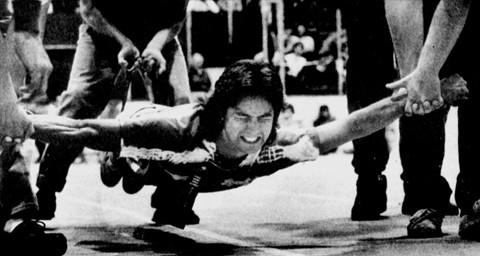
Despite our longtime enthusiasm for ski jumping, we just can’t seem to drum up much interest in this edition of the Winter Olympics. Perhaps that’s because we currently find ourselves smitten with an entirely different set of cold-weather games—those which comprise the World Eskimo-Indian Olympics, held annually in Fairbanks, Alaska. Most are simple tests of sheer strength and agility, and rely on equipment no fancier than a greased pole or loop of string.
Our favorite, though, requires only a couple of pals and the heart of a lion: Drop the Bomb, an event described in great detail in a 1989 Anchorage Daily News dispatch:
The athletes, holding their bodies in the cross position and parallel to the floor, are carried by the wrists and ankles until they no longer are able to remain rigid and touch the floor, hence drop the bomb…
Going last was defending champion Homer Lord of Fairbanks, who currently lives in Colorado. But he never could get in the iron-cross position the way he wanted to and finished a disappointing fourth.
“I didn’t get set properly,” he said. “Technique is a big part of this thing. You’ve got to lock yourself up because once you slip, you can’t go back. I didn’t get locked in.”
The world record of 266 feet has apparently stood for 23 years now. Which we guess makes record-holder Jeff Maupin the Yuriy Sedykh of Drop the Bomb.
→ 8 CommentsTags:Alaska·Drop the Bomb·Native Americans·sports·Winter Olympics·World Eskimo-Indian Olympics
Cashed Out
February 11th, 2010

A few days back, we touched on the challenges of undermining one’s enemy by counterfeiting his currency. Today we’d like to shift the focus to another tactic of fiscal warfare: issuing a new currency upon seceding from a national union. We all know the Confederacy did it back in the day, but it has become an exceedingly rare step in contemporary times. Take, for example, the Tamil Tigers, who succeeded in briefly creating a de facto government on the Jaffna peninsula, complete with its own police force and school system. But the Tigers never went so far as to issue their own currency, for several good reasons. For starters, printing counterfeit-proof currency is incredibly expensive nowadays, and a fledgling nation would certainly be more susceptible to fiscal subterfuge than an established counterpart. On top of that, it’s just bad economics to use a currency that no one outside your borders will accept—it makes trade umpteen times more difficult.
But there is an obvious symbolic power to having your own currency, and that seems to have been the lure for the secessionist government of Biafra, which existed from 1967 until 1970. The Biafran regime issued its own currency in 1968, and then printed a second series of notes a year later. This second series was notable for its use of microprinting, then an incredibly novel anti-counterfeiting device. That indicates that the notes were likely printed at an advanced facility in Switzerland, and paid for by wealthy Ibgo exiles based in London.
Unfortunately for Biafra, the currency gambit did little to aid its secessionist cause:
Although Biafra had made a concerted effort to produce the second series of higher quality bank notes, it would appear that their circulation was limited. By the time the notes were introduced in 1969, the country controlled by the Biafran forces had been reduced to a circular area approximately 85 miles across (roughly 5,000 square miles) and all consumables had long been sold. When a foreign journalist, Michael Mok of ‘Life’ magazine, asked a nun working with the Biafrans whether he could make a cash donation to help the starving children, he was told that cash would be useless, as there was nothing left to buy in Biafra. This may have been one of the reasons why so many Biafran notes remained in Europe undelivered – they were a cargo that could bring little practical purpose.
The Biafran pound has enjoyed a brief afterlife along the Togo-Benin border, where traveling Igbo traders do significant business. The going rate as of 2005 was 270 Nigerian naira to one Biafran pound.
Can anyone else think of contemporary secessionist movements that have dared to issue their own currencies? Extra credit (and free Microkhan mesh hat) if you can dig up an image.
Rhymes for the Deluge
February 10th, 2010
A minor blizzard out here in Atlah today, and we’re using the weather as an excuse to steal some time for our Secret Major Project™. Back soon with all the information you know and love; in the meantime, please enjoy the decidedly NSFW cut above. Seriously, do not hit play if you’re in a Puritanical environment and lacking headphones; your boss will not appreciate Lord Finesse’s potty mouth.


